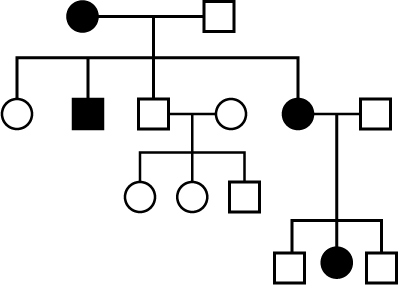NEET Exam > NEET Questions > Study the pedigree chart of a family showing ...
Start Learning for Free
Study the pedigree chart of a family showing the inheritance of myotonic dsytrophy

The trait under study is
- a)dominant X-linked
- b)recessive X-linked
- c)autosomal dominant
- d)recessive Y-linked
Correct answer is option 'C'. Can you explain this answer?
| FREE This question is part of | Download PDF Attempt this Test |
Verified Answer
Study the pedigree chart of a family showing the inheritance of myoton...
Autosomal domionant trait can express its effect in homozygpous as well as heterzygous condition.

|
Explore Courses for NEET exam
|

|
Similar NEET Doubts
Study the pedigree chart of a family showing the inheritance of myotonic dsytrophyThe trait under study isa)dominant X-linkedb)recessive X-linkedc)autosomal dominantd)recessive Y-linkedCorrect answer is option 'C'. Can you explain this answer?
Question Description
Study the pedigree chart of a family showing the inheritance of myotonic dsytrophyThe trait under study isa)dominant X-linkedb)recessive X-linkedc)autosomal dominantd)recessive Y-linkedCorrect answer is option 'C'. Can you explain this answer? for NEET 2024 is part of NEET preparation. The Question and answers have been prepared according to the NEET exam syllabus. Information about Study the pedigree chart of a family showing the inheritance of myotonic dsytrophyThe trait under study isa)dominant X-linkedb)recessive X-linkedc)autosomal dominantd)recessive Y-linkedCorrect answer is option 'C'. Can you explain this answer? covers all topics & solutions for NEET 2024 Exam. Find important definitions, questions, meanings, examples, exercises and tests below for Study the pedigree chart of a family showing the inheritance of myotonic dsytrophyThe trait under study isa)dominant X-linkedb)recessive X-linkedc)autosomal dominantd)recessive Y-linkedCorrect answer is option 'C'. Can you explain this answer?.
Study the pedigree chart of a family showing the inheritance of myotonic dsytrophyThe trait under study isa)dominant X-linkedb)recessive X-linkedc)autosomal dominantd)recessive Y-linkedCorrect answer is option 'C'. Can you explain this answer? for NEET 2024 is part of NEET preparation. The Question and answers have been prepared according to the NEET exam syllabus. Information about Study the pedigree chart of a family showing the inheritance of myotonic dsytrophyThe trait under study isa)dominant X-linkedb)recessive X-linkedc)autosomal dominantd)recessive Y-linkedCorrect answer is option 'C'. Can you explain this answer? covers all topics & solutions for NEET 2024 Exam. Find important definitions, questions, meanings, examples, exercises and tests below for Study the pedigree chart of a family showing the inheritance of myotonic dsytrophyThe trait under study isa)dominant X-linkedb)recessive X-linkedc)autosomal dominantd)recessive Y-linkedCorrect answer is option 'C'. Can you explain this answer?.
Solutions for Study the pedigree chart of a family showing the inheritance of myotonic dsytrophyThe trait under study isa)dominant X-linkedb)recessive X-linkedc)autosomal dominantd)recessive Y-linkedCorrect answer is option 'C'. Can you explain this answer? in English & in Hindi are available as part of our courses for NEET.
Download more important topics, notes, lectures and mock test series for NEET Exam by signing up for free.
Here you can find the meaning of Study the pedigree chart of a family showing the inheritance of myotonic dsytrophyThe trait under study isa)dominant X-linkedb)recessive X-linkedc)autosomal dominantd)recessive Y-linkedCorrect answer is option 'C'. Can you explain this answer? defined & explained in the simplest way possible. Besides giving the explanation of
Study the pedigree chart of a family showing the inheritance of myotonic dsytrophyThe trait under study isa)dominant X-linkedb)recessive X-linkedc)autosomal dominantd)recessive Y-linkedCorrect answer is option 'C'. Can you explain this answer?, a detailed solution for Study the pedigree chart of a family showing the inheritance of myotonic dsytrophyThe trait under study isa)dominant X-linkedb)recessive X-linkedc)autosomal dominantd)recessive Y-linkedCorrect answer is option 'C'. Can you explain this answer? has been provided alongside types of Study the pedigree chart of a family showing the inheritance of myotonic dsytrophyThe trait under study isa)dominant X-linkedb)recessive X-linkedc)autosomal dominantd)recessive Y-linkedCorrect answer is option 'C'. Can you explain this answer? theory, EduRev gives you an
ample number of questions to practice Study the pedigree chart of a family showing the inheritance of myotonic dsytrophyThe trait under study isa)dominant X-linkedb)recessive X-linkedc)autosomal dominantd)recessive Y-linkedCorrect answer is option 'C'. Can you explain this answer? tests, examples and also practice NEET tests.

|
Explore Courses for NEET exam
|

|
Suggested Free Tests
Signup for Free!
Signup to see your scores go up within 7 days! Learn & Practice with 1000+ FREE Notes, Videos & Tests.























